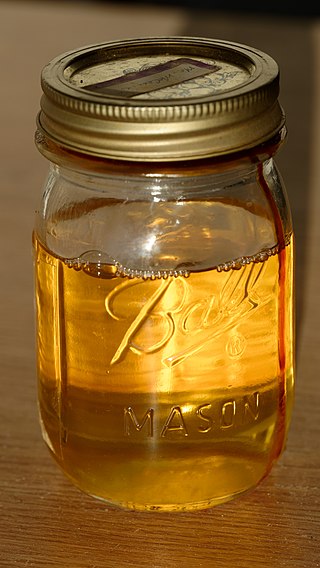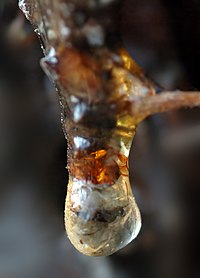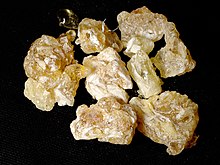
Lac is the resinous secretion of a number of species of lac insects, of which the most commonly cultivated is Kerria lacca.

Shellac is a resin secreted by the female lac bug on trees in the forests of India and Thailand. Chemically, it is mainly composed of aleuritic acid, jalaric acid, shellolic acid, and other natural waxes. It is processed and sold as dry flakes and dissolved in alcohol to make liquid shellac, which is used as a brush-on colorant, food glaze and wood finish. Shellac functions as a tough natural primer, sanding sealant, tannin-blocker, odour-blocker, stain, and high-gloss varnish. Shellac was once used in electrical applications as it possesses good insulation qualities and seals out moisture. Phonograph and 78 rpm gramophone records were made of shellac until they were replaced by vinyl long-playing records from 1948 onwards.

In polymer chemistry and materials science, a resin is a solid or highly viscous substance of plant or synthetic origin that is typically convertible into polymers. Resins are usually mixtures of organic compounds. This article focuses mainly on naturally occurring resins.

Turpentine is a fluid obtained by the distillation of resin harvested from living trees, mainly pines. Principally used as a specialized solvent, it is also a source of material for organic syntheses.

Incense is an aromatic biotic material that releases fragrant smoke when burnt. The term is used for either the material or the aroma. Incense is used for aesthetic reasons, religious worship, aromatherapy, meditation, and ceremony. It may also be used as a simple deodorant or insect repellent.

Varnish is a clear transparent hard protective coating or film. It is not to be confused with wood stain. It usually has a yellowish shade due to the manufacturing process and materials used, but it may also be pigmented as desired. It is sold commercially in various shades.

Lacquer is a type of hard and usually shiny coating or finish applied to materials such as wood or metal. It is most often made from resin extracted from trees and waxes and has been in use since antiquity.

Ziziphus mauritiana, also known as Indian jujube, Indian plum, Chinese date, Chinee apple, ber and dunks is a tropical fruit tree species belonging to the family Rhamnaceae. It is often confused with the closely related Chinese jujube, but whereas Z. jujuba prefers temperate climates, Z. mauritiana is tropical to subtropical.

Benzoin or benjamin is a balsamic resin obtained from the bark of several species of trees in the genus Styrax. It is used in perfumes and some kinds of incense and as a flavoring and medicine. It is distinct from the chemical compound benzoin, which is ultimately derived chemically from benzoin resin; the primary active ingredient of benzoin resin is actually benzoic acid, not benzoin.

Hymenaea courbaril, the courbaril or West Indian locust, is a tree common in the Caribbean, Central America, and South America. It is a hardwood that is used for furniture, flooring, and decoration. Its hard fruit pods have edible dry pulp surrounding the seeds. Its sap, called animé, is used for incense, perfume, and varnish.

Commiphora wightii, with common names Indian bdellium-tree, gugal, guggal, guggul, gugul, or mukul myrrh tree, is a flowering plant in the family Burseraceae, which produces a fragrant resin called gugal, guggul or gugul, that is used in incense and vedic medicine. The species is native to southern Pakistan and western India. It prefers arid and semi-arid climates and is tolerant of poor soil.

Kerria lacca is a species of insect in the family Kerriidae, the lac insects. These are in the superfamily Coccoidea, the scale insects. This species is perhaps the most commercially important lac insect, being a main source of lac, a resin which can be refined into shellac and other products. This insect is native to Asia.

Mastic is a resin obtained from the mastic tree. It is also known as tears of Chios, being traditionally produced on the island Chios, and, like other natural resins, is produced in "tears" or droplets.

Ramakanta Panda, MCh, is the chief consultant for cardiovascular thoracic surgery and the group CEO of the Asian Heart Institute, a speciality cardiac care hospital under the aegis of Asian Hospitals, at the Bandra-Kurla Complex in Mumbai, India. In 2002, he set up the Asian Heart Institute in India. Panda has performed about 28,000 successful cardiac surgeries as of 2022, including over 1,900 redo bypass surgeries. He was awarded the Padma Bhushan in 2010 by the Government of India. Known as "the man with the safest hands".

Schleichera is a monotypic genus of plants in the soapberry family, Sapindaceae. There is only one species, Schleichera oleosa, a tree that occurs in the Indian Subcontinent and Southeast Asia.

Mayureswar Wildlife Sanctuary is located in Tehsil Baramati in Pune district in Maharashtra, India. It is 74 km from Pune and 35 km from Daund.

The Central Institute of Agricultural Engineering (CIAE) is a higher seat of learning, research and development in the field of agricultural engineering, situated in the lake city of Bhopal, Madhya Pradesh, India. It is an autonomous body, an Indian Council of Agricultural Research subsidiary, under the Ministry of Agriculture & Farmer's Welfare, Government of India.
In the Indian state of Jharkhand, films are produced in various regional and tribal languages including Kudmali, Hindi, Nagpuri, Khortha and Santali. Film industry in state of Jharkhand is also known as Jhollywood.
Myllocerus dentifer, is a species of weevil found in India, Pakistan and Sri Lanka.
Ranchi Sadar subdivision is an administrative subdivision in the Ranchi district of the South Chotanagpur division in the state of Jharkhand, India.























